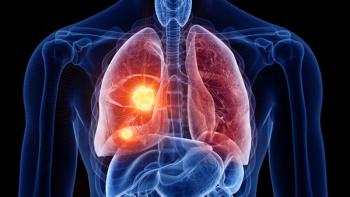
AB011 Plus Chemotherapy Associated with Early Clinical Benefit in Advanced Gastric/GEJ Cancer
The addition of AB011 to chemotherapy yielded initial clinical responses in patients with gastric cancer or gastroesophageal junction adenocarcinoma.
Combined treatment with AB011 and CAPOX (capecitabine/oxaliplatin) demonstrated early clinical benefit as a frontline treatment for patients with gastric cancer or gastroesophageal junction (GEJ) adenocarcinoma. Moreover, the safety profile is manageable, according to findings from the phase 1 AB011-ST-01 trial (NCT04400383) presented during the 2023 Gastrointestinal Cancers Symposium.1
Among 23 evaluable patients who received the combination and had at least 1 post-treatment tumor assessment, the confirmed overall response rate (ORR) was 52.2%. The ORR was 53.8% in the patients treated with 20 mg/kg of AB011 (n = 13) and 50% in those treated with 30 mg/kg of the agent (n = 11). Notably, the disease control rate was 100% in this population. Regarding safety, 37.5% experienced serious treatment-emergent adverse effects (TEAEs); however, no dose-limiting toxicities (DLTs) or treatment-related AEs leading to death occurred.1
Additionally, of the 35 patients with advanced solid tumors who received AB011 monotherapy across different lines of treatment, 2.9% achieved a complete response (CR), 22.9% had stable disease, and 8.6% had non-CR/non-progressive disease. Single-agent AB011 was noted to have an acceptable toxicity profile; 1 patient with gastric cancer who received the agent at a dose of 30 mg/kg experienced grade 3 dyspnea, which was a DLT.1
“AB011 monotherapy and AB011 combined with chemotherapy showed a manageable and tolerable safety profile in solid tumors,” lead study author Jin Li, MD, PhD, chief physician, professor, and the director of the Department of Oncology at Shanghai East Hospital, Tongji University, in China, and colleagues, wrote in a poster presentation. “No differences were found in safety and preliminary efficacy between 20 mg/kg and 30 mg/kg doses [of AB011] in combined therapy.”
CLDN18.2 is considered a potential therapeutic target because it is expressed in gastric mucosa and various cancer types. In preclinical studies, the humanized, anti-Claudin18.2 monoclonal antibody displayed synergy with cytotoxic agents.
The AB011-ST-01 study was launched to evaluate the safety and preliminary efficacy of AB011 as monotherapy and in combination with CAPOX. Investigators enrolled patients aged 18 to 80 years with histologically or cytologic confirmed advanced solid tumors in whom standard treatment failed, who had no standard treatment regimen available, or who had no access to standard treatment.2 Patients were required to have CLDN18.2-positive tumors, an ECOG performance status of 0 or 1, expected survival of more than 3 months, and good organ function.
In the dose-escalation portion of the trial, AB011 monotherapy was evaluated at doses ranging from 1 mg/kg to 30 mg/kg. The dose-expansion stage of the research further explored the agent given at doses of 20 mg/kg and 30 mg/kg. AB011 was infused on days 1 and 15 of each 28-day cycle.1 In the combination arm, AB011 was administered at 20 mg/kg or 30 mg/kg, in combination with CAPOX, as part of a 21-day cycle as a first-line treatment in patients with advanced gastric cancer or GEJ adenocarcinoma.
The primary end points of the trial were safety and DLTs for both the monotherapy and combination regimen. Secondary end points included pharmacokinetics and efficacy.2
Of the 35 patients in the monotherapy group, 26 had advanced gastric cancer or GEJ adenocarcinoma and 9 had pancreatic cancer. The median follow-up in this group of patients was 13.14 months (interquartile range [IQR], 6.05-19.81).1 The combination arm was comprised of 24 patients with gastric cancer and GEJ who were evaluable for safety, including 13 patients who received 20 mg/kg of AB011 and 11 patients who received 30 mg/kg. The median follow-up in this group was 5.16 months (IQR, 2.83-6.64).
In the monotherapy arm, the median age was 61 years (range, 26-77), 71.4% of patients were male, and 97.1% of patients had an ECOG performance status of 1. Additionally, 62.9% of patients had received less than 3 prior lines of therapy, and 25.7% of patients received 3 or more prior lines of therapy.
Of the patients with gastric cancer or GEJ adenocarcinoma in the monotherapy cohort, 11.5% had a Lauren classification intestinal type, 11.5% had diffuse type, 15.4% had mixed type; this information was unknown in 61.5% of patients. Additionally, 15.4% of patients had signet ring cell carcinoma and half of patients had less than 3 metastatic organs. Moreover, 53.8% of patients had peritoneal metastases and 34.6% had liver metastases. For the 9 patients with pancreatic cancer in this cohort, 8 had metastatic disease, 1 had peritoneal metastases, and 5 had liver metastases.
In the combination arm, the median age was 63.5 years (range, 35-78); 75% of patients were male and 95.8% had an ECOG performance status of 1. The primary lesion was gastric cancer in 91.7% of patients and 8.3% had GEJ adenocarcinoma. Additionally, 8.3% had singlet ring cell carcinoma. Seventy-five percent of patients did not have a history of gastrectomy. Lauren classification types included intestinal (16.7%), diffuse (12.5%), mixed (8.3%), and unknown (62.5%). Moreover, 45.8% of patients had 3 or more metastatic organs, 33.3% had peritoneal metastases, and 37.5% had liver metastases.
Within the monotherapy arm, spanning dose levels, the median number of infusions received was 2.0 (range, 1-40). AB011-related TEAEs occurred in 97.1% of patients, and 20% had serious AB011-related TEAEs. Grade 3 or higher TEAEs were reported in 40% of patients, and 22.9% had grade 3 or higher TEAEs related to AB011.
In the combination arm, the median number of infusions received, spanning doses, was 5.5 (range, 1-17). All patients experienced AB011-related TEAEs, 20.8% had serious TEAEs related to AB011, and 25% had serious TEAEs related to AB011 or chemotherapy. Additionally, 62.5% of patients reported grade 3 or higher TEAEs, 41.7% had grade 3 or higher TEAEs related to AB001, and 58.3% had grade 3 or higher TEAEs related to AB011 or chemotherapy.
The most common AB011-related TEAEs observed in the monotherapy group were vomiting (any grade, 82.9%; grade ≥3, 8.6%), nausea (62.9%; 0%), hypoalbuminemia (34.3%; 2.9%), hypophagia (28.6%; 0%), asthenia (28.6%; 0%), and anemia (20.0%; 2.9%).
The most common AB011-related TEAEs reported in the combination group included nausea (any grade, 83.3%; grade ≥3, 12.5%), vomiting (66.7%; 4.2%), hypoalbuminemia (54.2%; 8.3%), decreased weight (50%; 0%), anemia (33.3%; 8.3%), asthenia (25%; 0%), and hyponatremia (20.8%; 0%).
References
- Li J, Pan H, Liu T, et al. A multicenter, phase 1 study of AB011, a recombinant humanized anti-CLDN18.2 monoclonal antibody, as monotherapy and combined with capecitabine and oxaliplatin (CAPOX) in patients with advanced solid tumors. J Clin Oncol. 2023;41(suppl 4):391. doi:10.1200/JCO.2023.41.3_suppl.391
- Clinical trial to evaluate AB011 injection in patients with CLDN18.2-positive advanced solid tumors. ClinicalTrials.gov. Updated January 6, 2023. Accessed February 8, 2023.
https://clinicaltrials.gov/ct2/show/NCT04400383
Newsletter
Knowledge is power. Don’t miss the most recent breakthroughs in cancer care.































































































